Posted by
Shay Harel
As COVID-19 continues to rage on Google has been quite adept at updating the SERP accordingly. While March saw the introduction of major COVID-19 elements to the SERP, this past month saw Google refine the way it handles the pandemic.
But wait, that’s not all. April also saw Google set its shopping experience free… literally. Add on a few notable tests and changes and you have yourself quite the brimming month on the Google SERP.
This is the May 2020 edition of the SERP News!
Google’s Latest Round of COVID-19 Changes
In last month’s edition of the SERP News, we covered the absolute monster of a SERP feature that Google is using to handle some queries related to COVID-19. While over the course of April there was not anything that dramatic inserted onto the SERP, Google kept itself busy ensuring it was covering COVID-19 appropriately.
Here’s a rundown of what’s changed:
Online Care Options Added to Local Listings
Google has brought highly-detailed COVID-19 information where it matters most, medical facility listings. Google’s business panels related to medical facilities now offer the ability to present how to handle physical visits to the facility in light of COVID-19 and if there is the possibility for an online care visit.
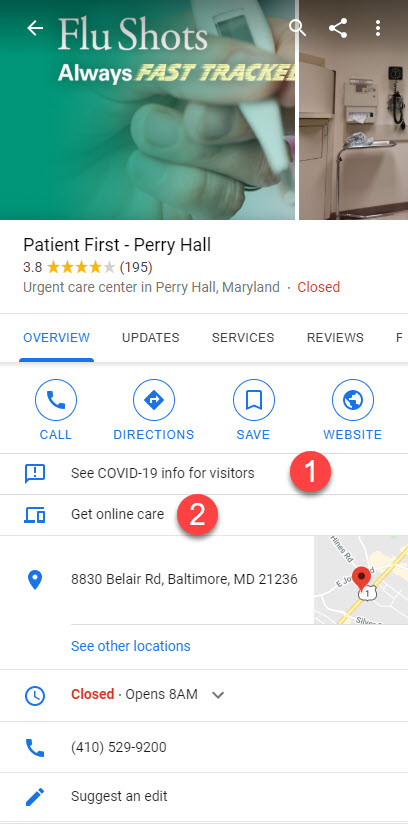
The Local Panel showing links to COVID-19 visitor info and access to online medical care
These are extremely valuable and well-placed features. For example, the below page from Beth Israel Hospital in Boston offers information on how to go about various kinds of visits to its facilities as accessed via the Local Panel:

As you can see, this information is incredibly valuable to the user and it makes absolute sense that it can be accessed via the business listing. The only thing I don’t understand is that these new elements are only available on mobile. Neither the access to information pertaining to physical facility visits nor the online care links are presented on desktop.
Personally, I’d very much like for Google to update the Local Panel on desktop as well, especially since desktop usage during this pandemic is up.
COVID-19 Oriented Google Posts
Business owners can now create Google Posts that specifically offer COVID-19 updates. Within Google My Business you will now see an option to create a post that reflects COVID-19 information as it relates to your business. This is another instance of Google taking a very thoughtful and comprehensive look at what is needed to adequately address the business side of the pandemic.
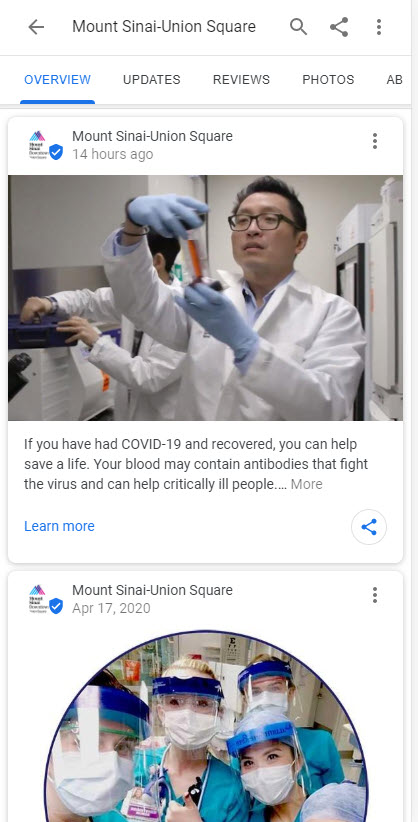
Google Posts Showing COVID-19 content
In creating COVID-19 focused Google Posts, the search engine is in line with its own recommendation that business owners update their site to reflect any changes that have resulted due to COVID-19. With the use of Google Posts, a business is in position to update its consumers who access the brand via the SERP as to how COVID-19 is impacting its functioning.
One point to note is that Google Posts generally have a 7-day shelf life, which would be something to look into if you create COVID-19 Google Posts.
Google Maps Indicates Takeout & Delivery Status
With COVID-19 keeping most people at home, Google Maps now indicates if an eatery offers takeout and/or delivery. To see the labeling you have to be zoomed in on a specific area. That is, a query that covers a large area will not initially show the takeout or delivery status of an eatery. To see these labels you have to zoom in so as to have the map cover only a very specific area.
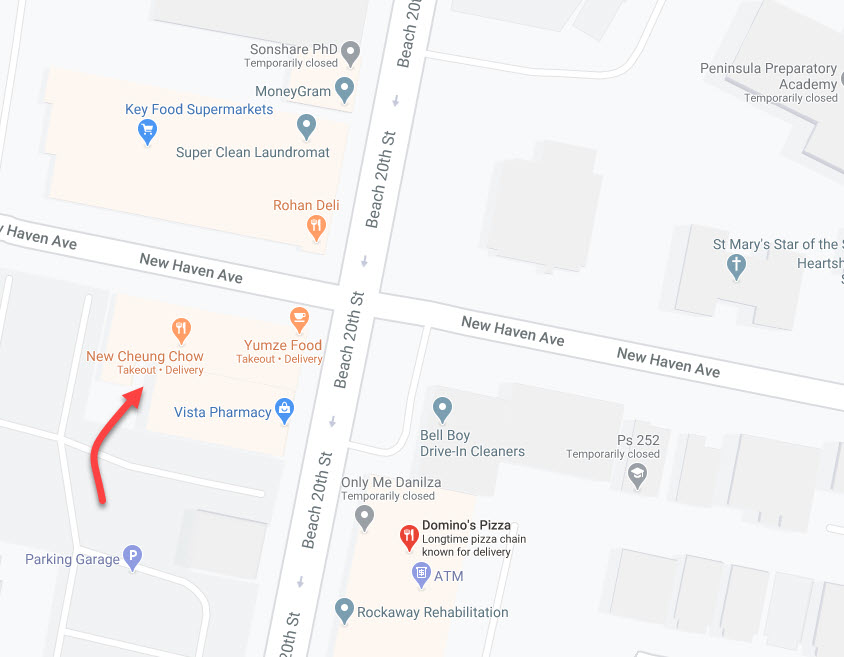
Local eateries now show takeout and delivery status on the map
COVID-19 Accommodations in Local Service Ads
Similar to the insertion of COVID-19 content into the Local Panel, Google is letting its Local Service Ad advertisers present COVID-19 accommodations. To that, Google’s Local Service Ads now gives advertisers the option to indicate if they offer services/consultations via video, etc. Further, the options enable advertisers to list the COVID-19 safety precautions they are taking (such as offering curbside service so as to avoid direct contact with the customer).
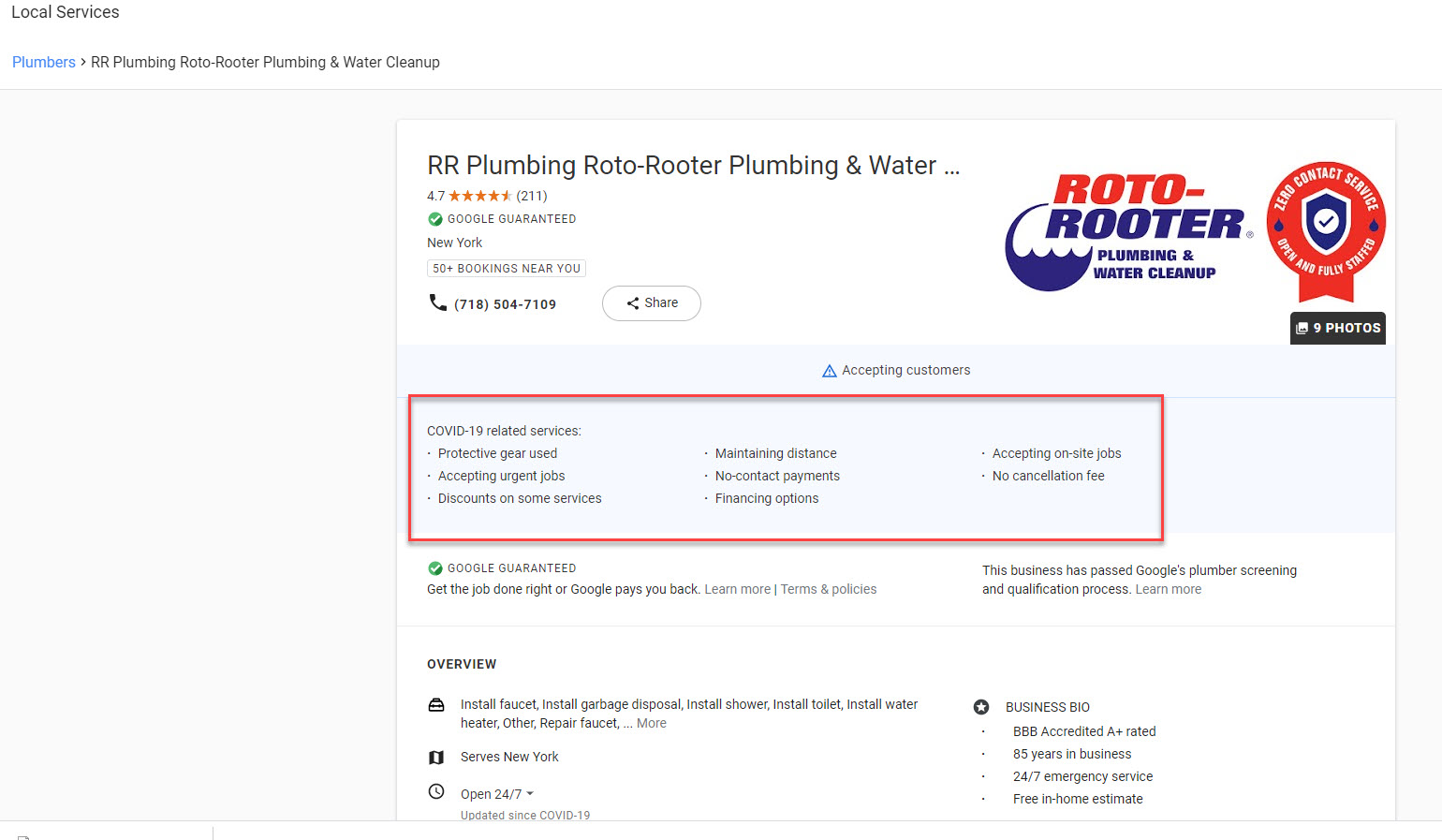
A Local Service Ad listing COVID-19-specific accommodations
Special Schema for COVID-19 Applies to All Sites
The SpecialAnnouncement schema meant to indicate messages regarding COVID-19 does not only apply to medical sites or government sites. Google confirmed that any site may implement the schema so long as the content aligns with COVID-19 information.
Speaking of schema, Google said they now support a special schema markup to indicate information related to COVID-19 stimulus funds and other related benefits.
{By the way, we recently added the ability to generate the code for SpecialAnnouncement markup to our free schema markup generator.}
Google Pushes Question Hub for COVID-19 Content
Way back when, Google tested an odd little box that let the user submit a custom question so that content could be developed to answer it. In such instances, if the user found the content on the SERP to be inadequate they could submit a custom question. The implication was that Google would share that question with publishers so that content could be created, crawled, and then indexed so that the next time a user searched for something similar adequate content would appear.
Google has actually been using this box in markets where there is simply not enough content being generated in a given language.
Now, Google is using this hub/box in the US for some queries related to COVID-19. The logic is a bit evident. Since Coronavirus is a singular event there may be a shortage of content related to certain topics that fall under its umbrella. Via the question hub, Google can partner with content publishers to ensure the right content is being developed.
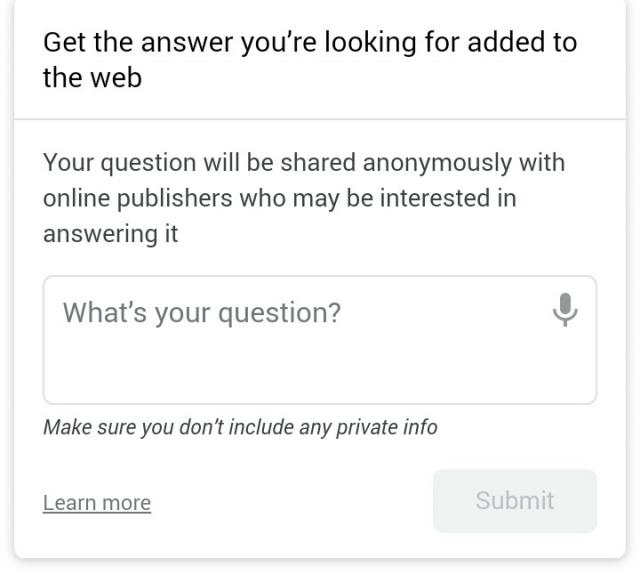
Google is implementing a box where you can submit questions for content creators to answer on some COVID-19 SERPs in the US
A Note About Authority’s Role In Ranking During a Pandemic
E-A-T expert, Marie Haynes, put out a Tweet reminding us that during a pandemic Google may weigh authority over factors such as relevancy. Specifically, in a document outlining how misinformation is prevented from appearing on the SERP and beyond, Google notes:
“… we have designed our system to prefer authority over factors like recency or exact matches while a crisis is developing.”
This, of course, is something to consider if your content touches on the current crisis.
Here’s the original Tweet from Marie:
Did you know that “while a crisis is developing”, Google can choose to prefer to rank the most authoritative sites? If you’ve lost rankings recently for YMYL queries, have you noticed that incredibly authoritative sites are dominating your SERPS? https://t.co/eJpa4ZOjH2 pic.twitter.com/Qp0g5T00KW
— Marie Haynes (@Marie_Haynes) April 21, 2020
Google Shopping Is Open to All with Free Product Listing
In light of businesses being increasingly forced to adopt a digital commerce model as a direct result of COVID-19, Google has made listing products within Google Shopping free for everyone. According to Google’s statement, the move to free Shopping listings has been in the works for some time but was expedited as a result of the current pandemic.
It should be noted, this does not mean the end of paid listings within Google Shopping. Rather, and much like the main SERP, paid listings will sit atop of organic product listings.
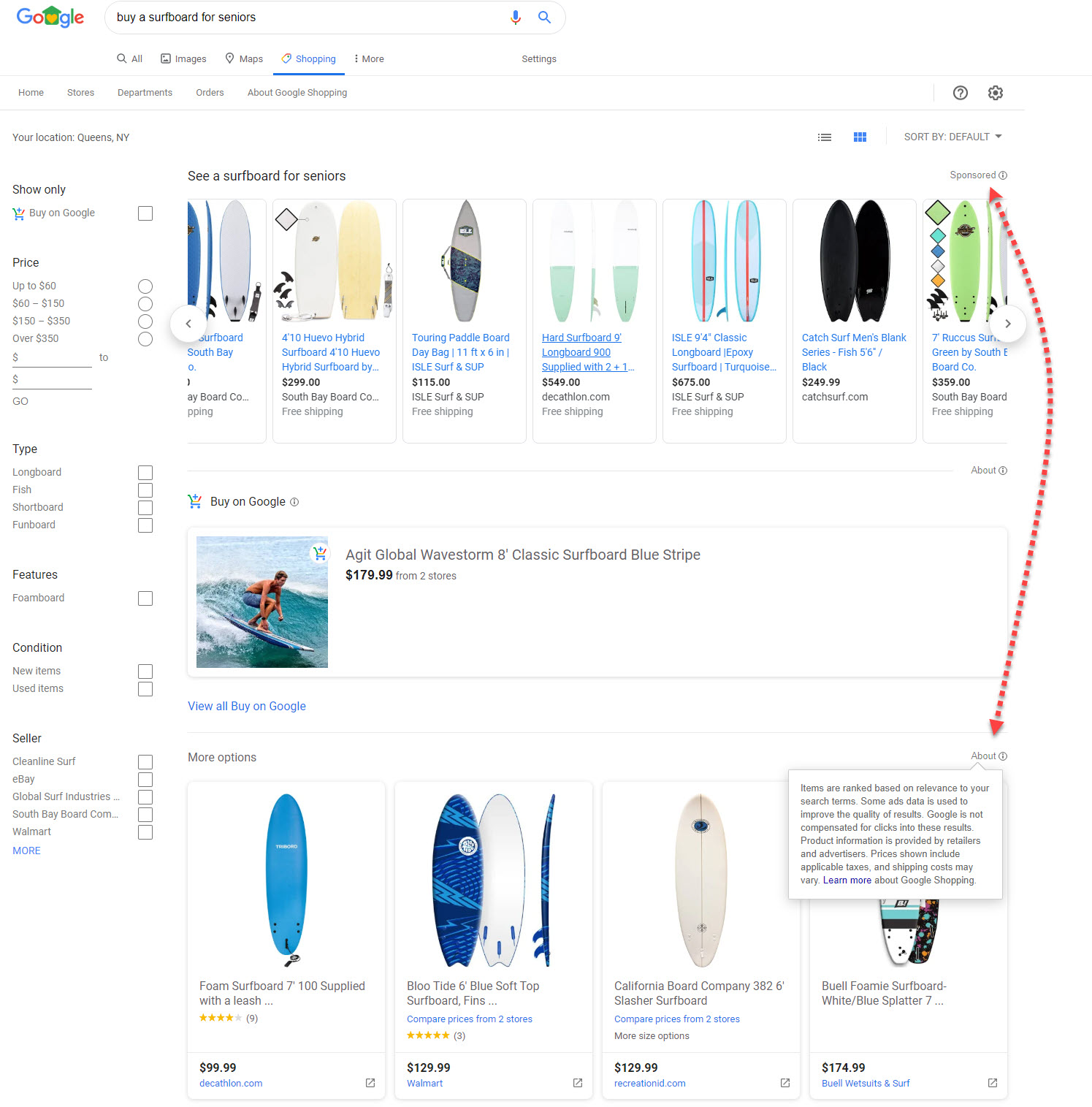
Organic listings now appear within the Shopping tab on the SERP
Obviously, there’s more to this than trying to help retailers impacted by COVID-19. Free listings mean more listings under the Shopping tab on the SERP. More listings mean a better ability (all things being equal) to compete with Amazon, which has long been a goal of the search engine.
The opening of product listings follows Google’s efforts to expedite the checkout process via a universal shopping cart just under a year ago.
Personally, my longstanding stance on the issue is that Google is too focused on things like accessibility and availability where it should be concentrating on user associations to its shopping platform:
Our host @MordyOberstein thinks there’s NOTHING Google can do to stare Amazon in the eyes… no matter how many free listings Google Shopping now includes.
Here’s why…. #OnlineShopping #Amazon#SearchMarketing #GoogleShopping pic.twitter.com/edp1ivKHJb
— The In Search SEO Podcast (@InSearch_SEO) April 29, 2020
To that, it’s highly likely that Google will find new ways to introduce the organic product listings from within the Shopping tab to the main SERP. Doing so, as should be evident, would greatly increase the visibility of Google’s shopping program.
The SERP Roundup Covering April 2020
Even though I get the sense that like many of us, Google has put some of its SERP testing/changes on hold as a result of the current crisis, there are still plenty of updates to discuss. Here are some of the tests and changes I’ve yet to discuss that have hit the SERP over the course of April 2020.
Advertising Verification to Expand as Website Links Come to Call Ads
Let’s kick this off by talking about some changes to Google Ads. First off, Google announced that its verification program will become universal come summer 2020. That is, all Google Ads advertisers will be required to confirm their identities by verifying profile elements such as their country of operations. This information will be visible, as it is now, directly from the SERP. The idea here is to prevent dishonest advertisers from ever appearing.
While on the topic of Google Ads, the search engine has said that a link to a website can be placed within a Call Ad.
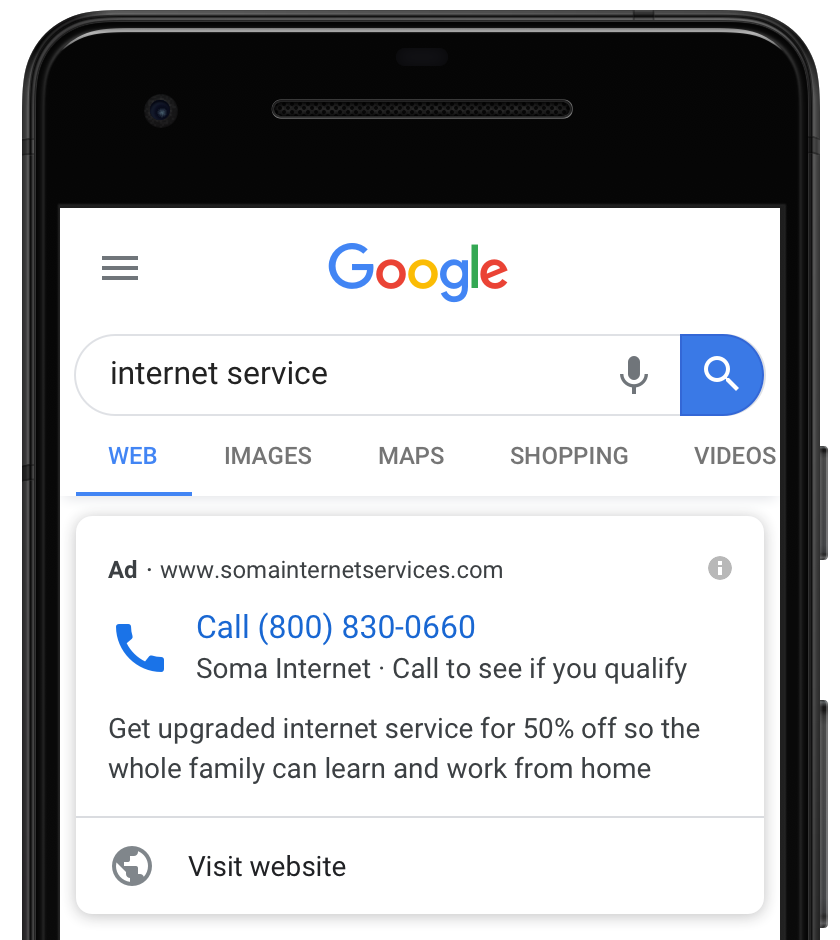
A Call Ad showing a link to the advertiser’s website (Image Source: Google Blog)
New Feature for When Results Prove to be Inadequate
In a way similar to the question hub discussed above, Google has announced a new feature meant to help users when the search engine cannot serve high-quality results.

Google’s new feature offering search tips and alternate queries that appears when the search results prove to be less than adequate (Image Source: Google Blog)
There’s a lot to chew on here. What stands out is that this is not the usual Did you mean “x”. Meaning, in instances where the new feature appears, Google is truly stumped (at some level) as to what should appear. Some have speculated that this would indicate that perhaps some of Google’s machine learning properties need further input to continue to grow.
The idea that Google is fishing for input makes a great deal of sense to me as the new feature offers the user two possible searches that they want to try in place of the one done originally. This seems very much like Google running an A/B test using the decided upon option as a way to confirm or extend its query understanding.
Smaller SiteLinks Spotted
Over the course of the month, Google has been treating me to a smaller set of SiteLinks. Smaller not in the amount of them, but rather their font size.
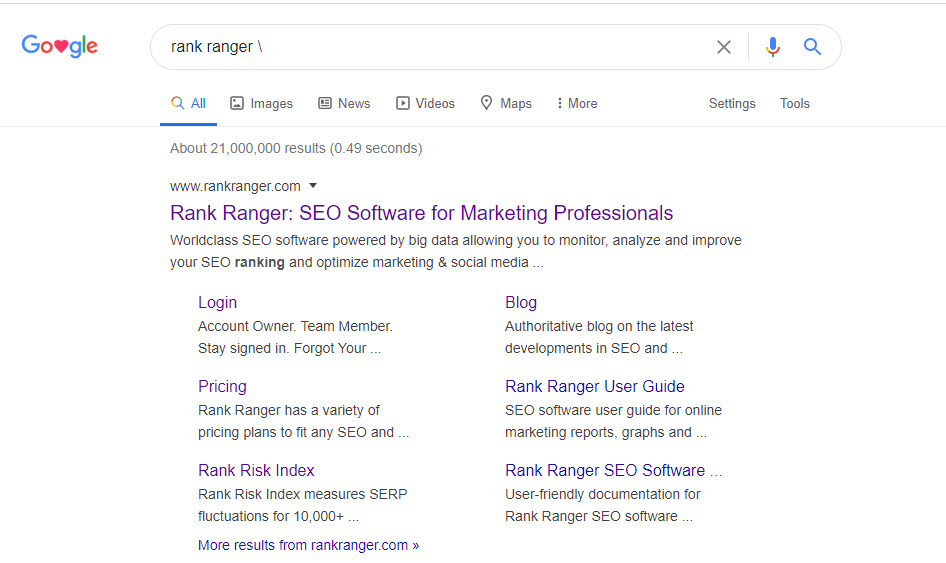
Google testing a set of SiteLinks that use a smaller font when compared to the result’s title
In a way, I kind of like the smaller font as it helps to differentiate the links from the result’s title. I asked around if others were seeing this and it would appear that the test is very limited.
More Sidebar SERPs Spotted
The sticky sidebar menu made famous by how Google shows information related to COVID-19 has seen expanded testing. Google has tested this format in the past (though, as a cruder prototype) but reports indicate that its testing is becoming more widespread.
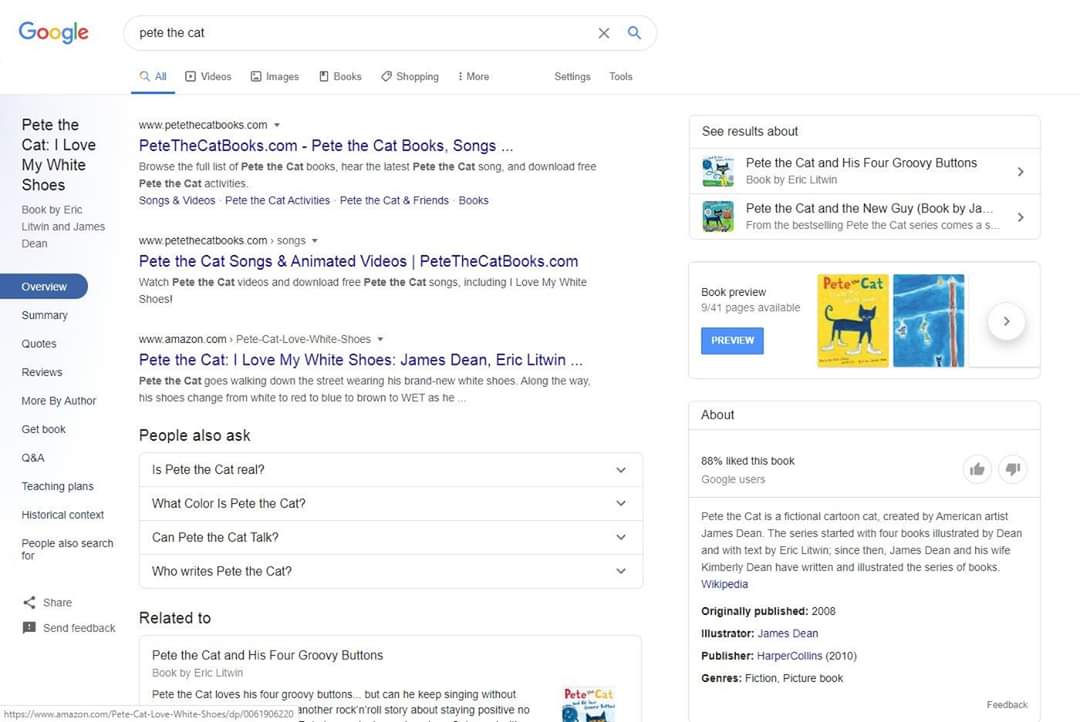
A SERP for a book showing with a side menu that represents Knowledge Panel tabs
This makes total sense to me as I believe the functionality enables Google to achieve some of its more complex goals around personalization (which I outlined in a recent Search Engine Land article). It’s worthwhile to note that the implementation for queries related to COVID-19 represents a bit of a divergence from the way the functionality is used within the tests. That is, the recent testing focuses on breaking down entities much the way a mobile Knowledge Panel would. Meaning, the side menu offers a segmented look at a person or a thing and presents the same tabs the mobile panel would.
The COVID-19 implementation of the functionality goes one step beyond that in that it takes a topic and segments it according to highly-relevant subcategories of information. That’s a bit more complex than showing a side menu tab for “People also search for.”
Reviews Are Back on the SERP
As COVID-19 began wreaking its far-reaching havoc, Google decided to make leaving and replying to reviews impossible. As of April 9th, Google again made it possible to leave and reply to reviews. The “re-opening’ of reviews also means that the usage of the Q&A feature, the creation of ‘shortnames’, etc. has also been reinstated.
New How-To Schema Format Surfaces
There appears to be a new way for How-to schema markup to appear on the SERP. The new format shows steps listed vertically (as opposed to via a carousel) that do not contain any images. Each step has a link within it, but they all seem to take you to the top of the page (i.e., they are not jumplinks) which is a bit odd.
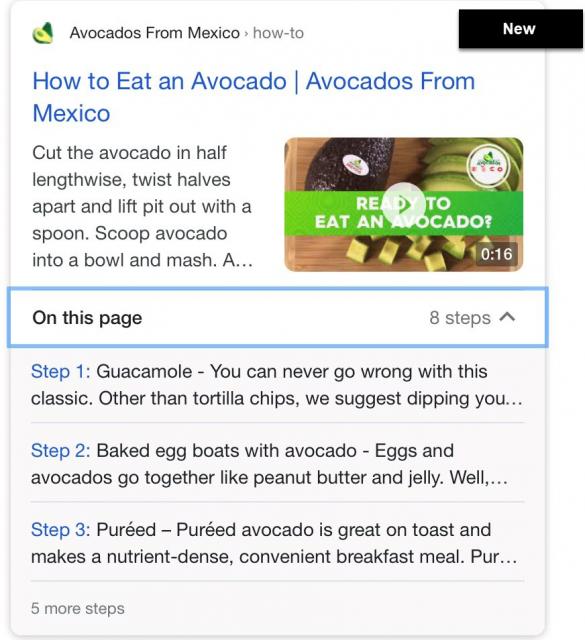
A new format for the ‘How-to feature’ shows a list of steps with a link to the site placed within each step (Image Source: SERoundtable.com via Brian Freiesleben)
Judgement Ruled in Case of French Publishers Versus Google
Google has been in a long legal battle over how it treats news publishers on the French SERP. You may remember that this led to Google essentially pulling all images off the French SERP at one point. An early April ruling now says that Google is obligated to pay French publishers for the use of their content within Google News as well as on the SERP and beyond.
It’s not clear how this will all play itself out in the end and what the final arrangements will be (one idea is for Google to completely abandon its showing of news content within SERP features on EU SERPs, etc.).
That said, the judgment is a significant moment in SEO history as the ruling could have a spillover effect into other markets outside of France or even the EU.
More Than Meets The Eye

Whatever your thoughts are on why Google is offering a way to directly submit questions for answering as well as notifying users when the results shown could use some work, there’s something deep going on here. There is something ‘big’ going on. Whether it relates to generating content where much might not exist or nudging machine learning along, something unsaid is happening here. I don’t think we can really know Google’s full intentions. I just find the fact that both of these features have found themselves on the SERP at the same time very telling. To me, it says there’s something deeper than we think going on here!
What do you think?

